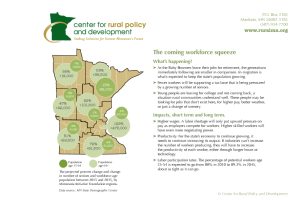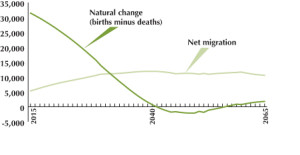
For some parts of the state, it’s already here and has been since before the last recession. For other areas, the full effect is yet to come, but it’s expected, according to the Minnesota State Demographic Center. It’s the coming workforce squeeze. It’s a demographic phenomenon planners have been warning about for years, and now it’s here. By 2035, Minnesota’s 65+ population is expected to grow by 93%, or 784,000 seniors, while losing 5% of its workforce-age population, or 170,000 people ages 15-64 as Baby Boomers pass the 65-year mark. As they retire, they are leaving jobs unfilled and there are not enough people to refill them, or at least not enough people in the right places with the right skills. The workforce won’t necessarily shrink over the next three decades, thanks to Baby Boomers who will continue working beyond 65, but the workforce won’t grow either, slowing to about 0.1% during the 2020s, according to the Minnesota State Demographic Center.
It’s a completely different workforce development problem from the one the state and U.S. economy has been facing for the last 60 years when policy makers had to figure out how to create jobs to employ all the Baby Boomers out there. Now the generations replacing the Baby Boomers aren’t numerous enough to fill those jobs.
To put numbers to the issue, we’ve created a fact sheet on the workforce squeeze showing the change in the size of age groups expected between now and 2035. Based on population projections put together by the Minnesota State Demographic Center, during this time period the state’s workforce-age population is expected to shrink as Baby Boomers “age out” of this age range and into the 65+ group, which will grow dramatically. After 2035, the workforce age group will then experience a modest rebound. This shift is happening now in Greater Minnesota, while the Twin Cities area is expected to experience an equally dramatic shift, just a few years later.

Data source: MN State Demographic Center
Regions of Greater Minnesota have been grappling with this challenge for many years. With a population that has been on average older because of a higher rate of out-migration from rural counties, it was inevitable that the workforce squeeze would happen here first. As well-run companies grew and as communities attracted employers, they found they didn’t have enough people to fill the jobs, or at least not enough of the right people with the right skills. Companies in southwestern and western Minnesota have been busing workers in from population centers for years. Managerial, creative and tech jobs are going unfilled, and an increasing number of employers are offering on-the-job training to teach the skills themselves.
What will the impact of this trend be? There are several:
➤ Fewer workers will be supporting a tax base that is being pressured by a growing number of seniors.
➤ Higher wages. A labor shortage will only put upward pressure on pay as employers compete for workers. Higher skilled workers will have even more negotiating power.
➤ Productivity. For the state’s economy to continue growing, it needs to continue increasing its output. If industries can’t increase the number of workers producing, they will have to increase the productivity of each worker, either through longer hours or technology.
➤ Labor participation rates. The percentage of potential workers age 25-54 is expected to go from 88% in 2010 to 89.3% in 2045, about as tight as it can go.
Here are some potential answers to the challenge:
➤ Recruit people instead of jobs. Individuals these days could bring their own job with them, and they may end up being a community’s next employer, says Ben Winchester of University of Minnesota Extension.
➤ Advertise jobs farther afield. Young people are more mobile than ever: one person may want to leave a community while another person may want to move there.
➤ Education is still crucial. According to the State Demographic Center, people with a bachelor’s degree are more likely to be employed than someone with only a high school diploma and will earn much more over a lifetime.
➤ Minorities and immigrants. They’re the only population group still growing, but their education and employment levels are still suffering. Help make sure they are ready for success in this new employment environment.
